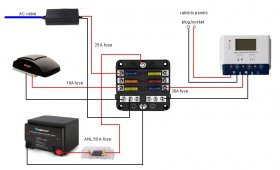HeathenNomad
New Member
- Joined
- May 18, 2022
- Messages
- 7
I did some searching and am still confused, as maybe my start is too simple. Right now, I have the following
2x200 Watt GrapeSolar panels hooked up in series IIRC with a 40 watt non-mppt controller
1 Renogy 50AH Lithium battery
1 Renogy 20 Amp AC-to-DC LFP Portable Battery Charger
1 MaxxAir Deluxe fan for our Sprinter
1 500W modified sine wave inverter for the 12V aux plug
I am trying to design a system where I can pull the controller, panels, and battery out for portable charging and put them back when I am done charging to power the fan. I also want to run the AC to DC charger via the inverter when I am driving, as a way to charge the battery until I can get a DC to DC charger hooked up in the van.
Right now, the controller connects to the panels with 10G wires that screw into the controller and the battery uses ?G lug cables to connect to the controller. My initial vision is to have a way to quickly disconnect the battery/charge controller from the fan for charging via a quick connect to the panels or to the CA to DC charger.
I am thinking I need the following at a min
Positive Battery -> Circuit Breaker/Fuse -> Controller -> Panels
Negative Battery -> Controller -> Panels
For the actual fan connections, I think I need this
Positive Battery -> Circuit Breaker/Fuse -> Fuse Panel Positive on the top
Negative Battery -> Fuse Panel Negative on the bottom
Fuse Panel to the fan from Neg/Pos terminals on the side
For this basic system, does one need bus bars and if so, how do you determine the size?, disconnect switches, shunts/monitors and can this all be added later when I expand?
Also, are there recommendations for quick connect/disconnect ideas for between the controller/panels and the controller/battery like Anderson Powerpoles, etc.?
TIA
2x200 Watt GrapeSolar panels hooked up in series IIRC with a 40 watt non-mppt controller
1 Renogy 50AH Lithium battery
1 Renogy 20 Amp AC-to-DC LFP Portable Battery Charger
1 MaxxAir Deluxe fan for our Sprinter
1 500W modified sine wave inverter for the 12V aux plug
I am trying to design a system where I can pull the controller, panels, and battery out for portable charging and put them back when I am done charging to power the fan. I also want to run the AC to DC charger via the inverter when I am driving, as a way to charge the battery until I can get a DC to DC charger hooked up in the van.
Right now, the controller connects to the panels with 10G wires that screw into the controller and the battery uses ?G lug cables to connect to the controller. My initial vision is to have a way to quickly disconnect the battery/charge controller from the fan for charging via a quick connect to the panels or to the CA to DC charger.
I am thinking I need the following at a min
Positive Battery -> Circuit Breaker/Fuse -> Controller -> Panels
Negative Battery -> Controller -> Panels
For the actual fan connections, I think I need this
Positive Battery -> Circuit Breaker/Fuse -> Fuse Panel Positive on the top
Negative Battery -> Fuse Panel Negative on the bottom
Fuse Panel to the fan from Neg/Pos terminals on the side
For this basic system, does one need bus bars and if so, how do you determine the size?, disconnect switches, shunts/monitors and can this all be added later when I expand?
Also, are there recommendations for quick connect/disconnect ideas for between the controller/panels and the controller/battery like Anderson Powerpoles, etc.?
TIA
Last edited:



